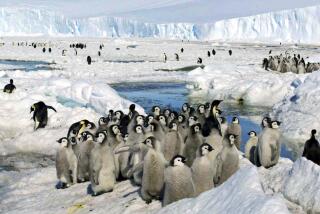Emperor penguinsâ feathers defy conventional wisdom, study finds
Emperor penguins eat, sleep and breed in one of the harshest environments in the world -- icy Antarctica, in temperatures that can dip below -40 in the winter. It would be easy to assume that they have the thickest, densest feathers in the bird world.
But a new study reveals thatâs not the case -- and that penguin coats are much more complex insulating structures than previously believed.
The findings, published in the Proceedings of the Royal Society B, could lead to a better understanding of penguin physiology -- and perhaps one day inspire makers of insulating materials.
Lead author Cassondra Williams, a comparative biologist at UC Irvine, said she first became interested in this question when she and her colleagues read in popular media and elsewhere that penguins had the highest feather density among birds -- but they couldnât find an original source for that statement.
âIt just seemed like somebody said it, and it got repeated and repeated,â Williams said.
The numbers in the literature related to the penguinsâ contour feathers -- the stiff, shapely plumes that resemble those used in quill pens. The contour feathers encase the body and the insulating layers below, keeping the cold water out and maintaining the bodyâs sleek profile. Estimates on these feather densities were all over the place -- some said there were 11 feathers per square centimeter; others said there were around 46.
But Williams and her coauthors had access to the bodies of penguins that had died on the ice, and they decided to put the mystery to rest, using three different birds. They soon found that counting penguin feathers was no easy task.
âAnytime we would try to even pull out a feather or separate the feathers with just our fingers, a lot of downy bits would come up,â she said, resulting in âa lot of tiny bits of downy feathers flying in the air.â
So the researchers snipped off the feathers -- as if giving the birds a close haircut -- and then counted the clipped feather shafts.
To their surprise, they found that while the feather density varied slightly from penguin to penguin, the contour feather density was around 9 per square centimeter -- less than a fourth as many as described in many previous papers.
And the emperor penguin definitely did not have the highest density of contour feathers in the bird world, they added: The white-throated dipperâs feather density is more than six times higher.
But a big surprise lay beneath those contour feathers. Penguins, as it turns out, have several types of feathers, including after-feathers -- little downy bits that are attached to the contour feathers -- and plumules, downy feathers that are attached directly to the skin. The emperor penguins had about four times as many downy plumules as contour feathers, so the plumules probably play a major part in the penguinsâ insulation.
Strangely, few papers had ever mentioned the presence of these plumules and the role they play, Williams said.
Nor did other scientists seem to notice even tinier feathers called filoplumes, which are hard to see without a microscope. These tiny feathers, which look like long stems with barbs at the very end, are used by flying birds to help sense when their plumage is disheveled, so they can groom it back into a more aerodynamic shape.
Though this idea hasnât been tested, itâs possible that these penguins are using filoplumes to keep their contour feathers streamlined to minimize drag in the water.
The findings may cause scientists to modify their understanding of how penguin bodies work and how they move. For example, researchers have long thought that penguins store air in their insulating feather coats so that they can release tiny bubbles that allow them to further reduce drag as they swim. Williams said these delicate, downy plumules could produce even tinier bubbles than the contour feathers, improving that drag reduction even more.
Follow @aminawrite on Twitter for more furry and feathered science news.







